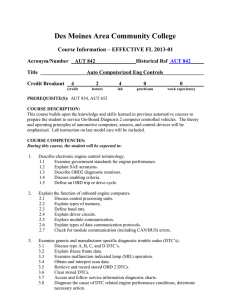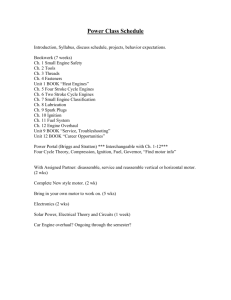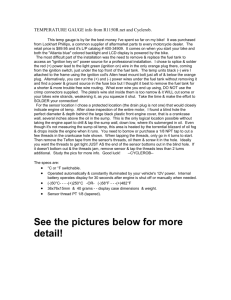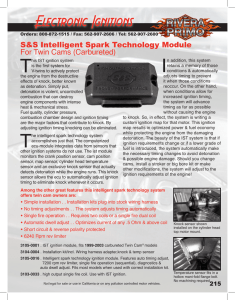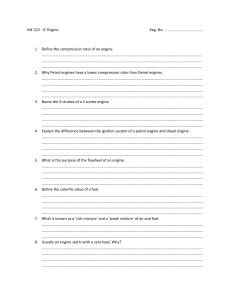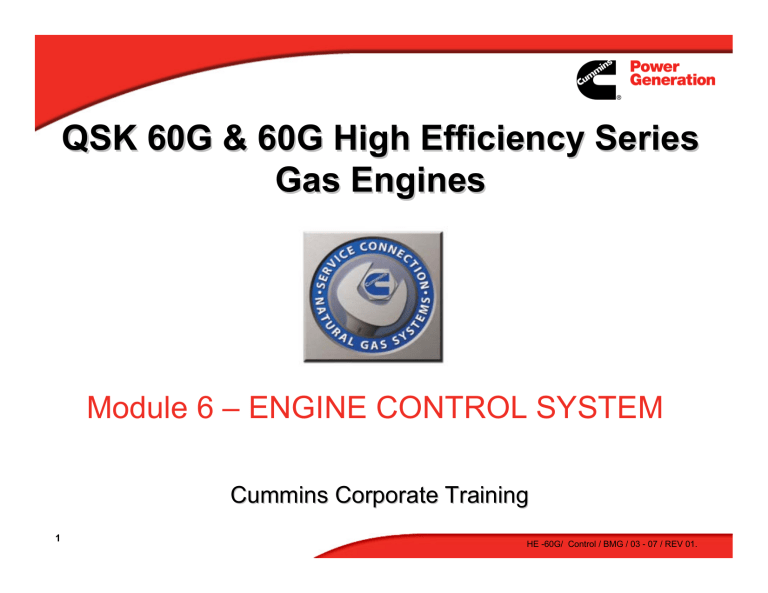
QSK 60G & 60G High Efficiency Series Gas Engines Module 6 – ENGINE CONTROL SYSTEM Cummins Corporate Training 1 HE -60G/ Control / BMG / 03 - 07 / REV 01. Engine Control System Learning Objective Participants will be able to locate and identify base engine control components and describe their operation within a total system. Agenda • Engine Control System - Capability & Integration. • Control Component location and function: - Control Module 700, - Systems Module 558, - Ignition Module, - CENSE / Control Module 850. • Ignition System. • Engine Sensors and Speed Probes. • System logic states. 2 Engine Control System Capability Continuous Monitoring of: – Lubrication System – Cooling – Air/Fuel handling – By cylinder (detects in-cylinder problems) – Others (operation hours/duty cycle, etc.) – Over 1200 fault codes mapable! Information Management for future analysis: –Trend Data for Engine performance, durability, and maintenance intervals. 3 QSK Gas Engine Control System Fully Integrated Controls: Fuel System-Ignition System-Governing-Genset CUMMINS SERVICE TOOL Sensor Signal CENSE / CM850 J 1939 PDM Bank 1 COP’S 1 - 8 Ref . Gnd . 8 Bit Bus Ref * PDM - Prognostic Diagnostic Module CCD - Capacitor Coil Driver MCM-700 Master Fire -320v CCD CAN 2.0B Combustion Combustion Controller Controller SSM-558 CM - 5XY Sensor Signal PDM IGNITION MODULE * Future development feature. Control System Schematic Ref . Gnd . 8 Bit Bus -320v Ref 4 Gnd. Fire CCD Gnd. Bank 2 COP’S 9 - 16 System Components – Standard QSK60G shown as example IGNITION RELATED :CM 558, IGNITION MODULE, COP. COP FUEL RELATED :CM 700, CM558. MONITORING ONLY:CENSE or CM850 CENSE Module or CM850 on High Efficiency version. CM 558 Ignition Module 5 NOTE : QSK60G shown CM 700 Mounted off engine in GIB. ( Generator Interface Box - GIB). CM700 Network Data Links Not fitted on Inline Gensets Peer to Peer (Multi-tasking) Data Link MODBUS (1900 baud) Slave J1939 (250K baud) SERVICE TOOL CONNECTOR Cummins Proprietary CAN 2.0B (500K baud) Master \ Slave (Point to Point) Data Link Peer to Peer (Multi-tasking) Data Link Master CENSE on H/E QSK 60G CM700 CENSE on standard QSK 60G CM558 CM558 k or w et N CM558 Networks constructed with twisted two core shielded cable. External terminating resistors fitted where indicated 120 Ohm - J1939 / CAN 2.0B 150 Ohm - MODBUS CM558 e on kb ac B e on kb ac B (SHIELD) k or w et N (-) N A C 9 93 J1 (+) GENSET PLC CM700 CONNECTION CHECKS Polarity - Terminating Resistors - Shield Connections Quantum - Gas Engine Control Components Note: H/E = High Efficiency Version CM 700 MODBUS link (19,200 baud) CM 558 Fire Sync J 1939 Network (250K baud) Ignition Module To Coil-on-Plugs 2, 3, 4, 5….. etc. Left Bank. COP Std 1 x CENSE ‘V’ Engines MODBUS Link to Genset PLC CAN 2.0 B Network (500 K baud) 7 H/E 60 x2 CM850 COP CM 558 Fire Sync Ignition Module To Coil-on-Plugs 2, 3, 4, 5….. etc. Right Bank. Master Control Module CM700 - Master Control Module: • Solid state fully encapsulated, one module required per system. • Located in Genset Interface Box (GIB) (door mounted). • Recognised by it’s 3 x 50 pin Deutsch connectors. • Non serviceable. 8 GIB - Genset Mounted Just one of the terminal boxes added as part of the Genset build. Generator Interface Box (GIB) Stay-in-Boot Switch and O2 Sensor Power Adapter Connector Socket Assembly NOTE: Preliminary Panel Layout HT & LT Engine Temperature Controllers Neutral Bar 37A DC PSU AC MCB’s KM (DC) Relays Solid-State Relays (Engine Temperature Control) CM700 Earth Bar Harting Connector (GIB to GCP) KM Contactor’s Fuse Rail 9 AC & DC Engine Connections Under Voltage J1939 Service Interlocked AC Isolator Relay Socket Generator Interface Box ( Continued ) • Houses the ‘Stay in Boot plug & socket’. ( Only used in special program functions). •Houses shutdown and isolation relays. • The CM700 • Has the Generator to Genset Control Panel interconnection Terminals. NOTE: KW Signal for the torque over boost closed loop control is supplied from Power Command Just one of the terminal boxes added as part Supervisor (PCS). A separate KW of the Genset build. transducer is no longer required or fitted Note: Service tool connector is located in the free standing genset control panel. 10 • CM 700 Function Vee engine Control systems HT Coolant Temperature HT coolant Pressure LT Coolant Temperature Turbo Speed Sensor (2.0Mw H/E QSV & QSK60G H/E only ) Lube Oil Temperature LT coolant Pressure Compressor Inlet Air Temperature (60 only ) Crankcase Blow-by ( When fitted ) Lube Oil Pressure Crankshaft Speed Note: H/E = High Efficiency Version MODBUS to Gen. PLC Speed Bias Signal Shutdown Signal Engine Man. Switch Genset Load (KWL) Idle / Rated switch (PLC) Stop / Start Switch (PLC) Utility Breaker Status (PLC) FROM PCS CM 700 Speed Governing + Base Engine Protections Safety wire loop / Power down Relay Ign. Engine Exh. Thermocouples Start Solenoid Fuel Shut off Valve CM 558 CENSE CM 558 Ign. Standard arrangement shown • Output Torque command (throttle driver signal) to CM558 Modules via CAN 2.0B data Link. • Exhaust Temp info sent to CM700 from Cense via J1939 data link, except on H/E Engines. • Total system data sent to genset Programmable Logic Controller via RS 485 data link. Fuel & Ignition Modules Ignition Module ( CCD) : Solid state fully encapsulated, controls up to 9 cylinders Non-serviceable. Two Amphenol connectors; one 19 pin - input from SM558, one 17 pin - outputs to COPs. CM558 - Sub Systems Module: Solid state fully encapsulated, controls up to 9 cylinders. Non-serviceable. Two Deutsch 50 pin connectors, one input from CM 700 one outputs to CCD. 12 Modules Mounted on Left and Right Bank side of Engine. Vee engine system with single fuel control valve and single throttle (QSK Engines ) CM558 Function Boost Pressure Intake Man.Temp & Pressure Fuel Inlet & Outlet Pressures.Fuel outlet Temp. Engine Speed & Position Gas Mass Flow Knock . Exhaust O2 & Back Pressure LEFT BANK SENSORS CM 700 CM 558 (Left Bank) Ign. Engine To Generator Control Panel (PLC) Throttle (Driver Signal) Throttle (actuator Position Feedback) Fuel Control Valve (Driver Signal) Fuel Control Valve (Position Feedback) Ignition Module (Sync / Fire Signals) Safety Wire Loop / Power Down Relay Compressor By-Pass Driver (H/E Only) Comp By-Pass Driver Feedback (H/E Only) LEFT BANK COMPONENTS CM 558 CENSE (Right Bank) Standard arrangement shown Ign. Ignition Module (Sync / Fire Signals) RIGHT BANK COMPONENTS RIGHT BANK SENSORS Engine Speed & Position Knock . Note: H/E = High Efficiency Version Duty Cycle Valve (FloTech) • Part of the gas control assembly. • Operates on the mark space ratio (duty cycle) of a 5v square wave signal from CM558. • Controls the gas supply to the mixer. • This electronic butterfly valve effectively controls the air / fuel ratio (mixture) for any given volume of fuel drawn through the gas control assembly as directed by the CM558. 14 Open / Closed Loop Control Air / Fuel ratio control on the engine in 3 basic modes: 1. Open-Loop. 2. Closed-Loop (with torque over boost feedback). NOTE : Engines will be shipped in Open-Loop mode. Open loop: Has advantage of simpler set-up, calibration and trouble-shooting. Closed loop: Will ensure emissions do not drift outside spec. Air / Fuel ratio control mode: The automated calibration in the service tool (INSITE) defaults the table in the ABank CM558 to to perform open-loop air / fuel ratio control. This default cannot be changed. Closed loop operation is switched on/off via service tool 15 Ignition System • DC to DC converter steps up the supply voltage to approx 300 v, which charges the capacitor. • Signal from CM 558 closes an electronic switch in the ignition module, the capacitor charge discharges into the primary windings of the Coil on plug ( COP). • The voltage induced into the secondary winding of the COP is supplied directly to the spark plug and rises (up to 40Kv) until it overcomes the resistance of the electrode to ground strap air gap. • The PDM is being developed as a future diagnostics tool. 16 Ignition Module DC TO DC CONVERTER CAPACITOR + P D M PRIMARY & SECONDARY WINDINGS COP 24V CM558 PLUG CCD Output Harness The Ignition Module output pins for firing sequence are fixed as shown in the table below.The harness connections therefore determine the cylinder firing order! Pin Type A B C D E F R P G J K L -Vdc 1 -Vdc 2 -Vdc 3 -Vdc 4 -Vdc 5 -Vdc 6 -Vdc 7 -Vdc 8 IGN-COP HVS-S HVS-GND HVS-SIG CCD/PDM - 17 Pin Output Connector Comments Ignition Coil Power * Dependant on firing order V12/16. Ignition Coil Power Ignition Coil Power Ignition Coil Power Ignition Coil Power Ignition Coil Power Ignition Coil Power Ignition Coil Power Ignition Coil Ground High Voltage Sensor shield. Connected to CCD-CDM case High Voltage Sensor Ground ref. Connected to GND at COP High Voltage Sensor Input Signal WARNING: Incorrect fitting can cause exhaust explosion. 17 To *COP#1 *COP#2 *COP#3 *COP#4 *COP#5 *COP#6 *COP#7 *COP#8 COP None COP COP Drive wheel for Camshaft position sensor pick-up QSK engines +1 pulse Drive wheel fitted to Left bank camshaft only. Dual output Sensor connected to Left & Right bank CM558. QSK 60 24+1 pattern + 1 pulse used to trigger ‘Ref’ signal for start of ignition cycle. Example of CM558 ‘Fire’ signal to Ignition module with Timing retard on cylinder 3. Cyl. Firing. +1 pulse ‘REF’ reset received ° ± ‘FIRE’ Ignition module will ‘Fire’ the spark plug on falling edge of signal. Ignition Module ‘REF’ The ‘Ref’ signal resets the Ignition Module counter that switches output to the Cylinder 1,2,3 etc. back to No 1 each time the camshaft position sensor reads the +1 pulse. Cyl. 1 Cyl. 2 Cyl. 3 Cyl. 4 Cyl .5 Cyl. 6 Cyl. 7 Cyl .8 Cyl. 9 Position Sensor & Speed Probes New pictures Required Engine Position Sensor One off Left - bank camshaft Dual Output Speed Probe: 1 to MCM700, 1 not used. Dual Output Speed Probe: CM558’s (output to Left & Right bank units). Speed probe Part No. 3865350 When installing check probes are over one of the teeth, set clearance to 0.8mm (back-off 3flats). 19 Engine Sensors IMPORTANT: Torque to 20Nm +/-2 Heated Oxygen Sensor : Knock Sensor: 1-off, fitted in left bank exhaust elbow OUTPUT: 0 - 5vdc.(Also requires 12v dc heater supply) ONLY FOR ERVICE USE. One per cylinder, fitted to head, pizzo electric crystal. Back Pressure Sensor : 1-off, fitted in left bank exhaust elbow 20 NOM OUTPUT: 1v dc. > 2.1 v IGN retarded 3º (twice then shutdown) > 4.5 v Immediate Engine Shutdown Engine Sensors Gas Mass Flow Sensor: • Located in the Gas Control assembly. • Operates on a 12v dc “hot wire” system, the output is up to 7.8v although the CM558 can only read up to 5.0v. • The gas control assembly is located towards the front end of the engine. • The information is then fed to the CSM 558 module which adjusts the duty cycle to give the correct gas flow as defined in the 558 control map. Ambient Temperature Sensor : • Compressor inlet temperature sensor is mounted in the left bank air filter housing to monitor ambient air temperature. 21 Engine Sensors P1 FUEL FLOW • P1 - Boost Pressure (before throttle actuator). • P2 - Intake Manifold Pressure (after throttle actuator). • T1 - Intake Manifold Temperature (after throttle actuator). THROTTLE ACTUATOR LEFT BANK MANIFOLD NOTE: All sensors feed Left bank CM558 for mixture control. Right bank CM558 has ignition only. 22 P2 T1 ProAct Driver & Actuator The ProAct III Actuator driver is mounted on the Genset The throttle actuator operates on a closed loop feedback system with the driver module in order to determine actuator position. This information is then fed back to the CM558 for display and trouble shooting. The ProAct III actuators are designed for larger gas and diesel engines not requiring governing backup systems. The primary features of the system are: – An all electric 75 degree rotary actuator, engine-mountable. – An adjustable driver with 4-20 or 0-200mA Control for connecting with many governor & control systems. – Extremely fast & accurate. 23 CENSE Module / CM850 Modules On the QSK60G, the CENSE module is located at the rear of the right bank intake manifold as shown. Its primary function is monitoring of the exhaust pyrometers mounted in each cylinder head exhaust passage. CENSE MODULE or CM850 LOCATION. Exhaust Pyrometer 24 NOTE: The CENSE module is replaced by two CM850 modules, one mounted on each bank on the QSK60G H/E. The function of the CM850 is the same as CENSE. CENSE Function – QSK60 G ONLY To Generator Control Panel (PLC) Service Connector RS 232 Exhaust Port Temperatures (Left Bank) CM 700 CM 558 Ign. J1939 Service Connector Engine TH1 TH2 TH3 TH4 TH5 TH6 TH7 TH8 J1939 CM 558 CENSE MODULE TH9 TH10 TH11 TH12 TH13 TH14 CAN 2.0B TH15 TH16 Ign. CENSE – Download via 9 pin D connector (RS232) in GIB or via INSITE and Engine Service Tool point. Exhaust Port Temperatures (Right Bank) • Thermocouples signals are connected to CENSE module K - Type inputs. The Cense module has 16 K-Type Inputs. 25 CM 850 Function – QSK60 G/HE ONLY J1939 CM 850 Service Connector (For INSITE Download ONLY). Monitor via HMI or System J1939 Service Connector and INSITE) To Generator Control Panel (PLC) CM 700 CM 558 Exhaust Port Temperatures (Left Bank) (Address 27) J1939 System Service Connector THA1 THA7 THA2 THA3 THA4 THA5 THA6 Ign. (Address 00) Engine THA8 J1939 CM 850 MODULE – LEFT BANK (Address 0xF1) CAN 2.0B CM 558 Ign. (Address 01) CM 850 MODULE – RIGHT BANK (Address 0xF2) THB9 THB10 THB11 THB12 THB13 THB14 THB15 THB16 CM850 – Download using INSITE connected via J1939 and 9 pin ‘D” connector in GIB ONLY. Exhaust Port Temperatures (Right Bank) • CM850 modules have no K-Type Inputs. Thermocouples with combined K - Type signal converters are connected to the CM850 modules. One module is mounted on each bank. The CM850’s are connected by, and communicate with, the CM700 via the CAN 2.0B network. • INSITE will auto detect module address. Engineering J1939 Service tools require module address input. 26 QSK60G HE – EG THERMOCOUPLES • CM850 modules have no K-Type inputs. Therefore Thermocouples with combined K - Type signal converters are connected to the CM850 modules. • • Thermocouple Pt.No. 495448. • Temperature Vs sensor output is shown in the table. The lower the output the higher the temperature. • Thermocouple The signal converter is built into the 3-pin harness plug. Pin Layout Harness pin-out is : Pin 1 –Sensor Supply from ECM. 5.0 v dc. 1 2 Pin 2 - Sensor ground. 0 v. Pin 3 – Sensor output voltage 0.2 to 4.2 v dc. Pin 4 – not fitted / used. 27 3 4 Temp ( C) V (out) 0 4.2 50 3.95 100 3.7 150 3.45 200 3.2 250 2.95 300 2.7 350 2.45 400 2.2 450 1.95 500 1.7 550 1.45 600 1.2 650 0.95 700 0.7 750 0.45 800 0.2 FSO Vent Fuel Shut Off Valves 1&2 1 Ignition Module L.Bank 2 Ignition Module R.Bank Throttle Driver. + 24v Fuel Control Valve E stop Pushbutton Circuit. Ground CM558 FSO/Vent Relay. V CM700 FSO/Vent Relay. Engine E -Shutdown indication to genset controls PLC E-Stop PCS E-Stop Battery Conservation Relay. + 24v + 24v E-Stop Pushbutton Relay. C26 B27 Shutdown Request E-Stop Input Isolated Battery (+24v) CM700 Isolated Battery (+24v) B39 A49 A50 C27 Switch Return + 24v Battery Conservation CM558B B48 Safety Wire A43 FSO Control Isolated Battery (+24v) CM558A A49 A50 Isolated Battery (+24v) Fuel Shut Off - Fuel Shut Off + Isolated Battery (+24v) A49 A50 A43 A44 Isolated Battery (+24v) CM700 Ignition Power down Relay. CAN Datalink + 24v + 24v Genset Controls E-Stop Relay. Normal Shutdown Request from Engine Controls to Genset Controls Shutdown & Isolation CM 700 System State Control STOP Stop/start switch = start and MXSRCNEN = 0 and ENGRPM = 0 Stop/start switch = stop and ENGRPM = 0 and authorized N_SHUTD condition is not active Authorized N_SHUTD condition occurred Keyswitch off and ENGRPM = 0 then keyswitch on OR power cycle Authorized E_SHUTD condition occurred Authorized N_SHUTD condition active Authorized E_SHUTD condition occurred N SHUTD Stop/start switch transition from stop to start and MMVENTSS = MUSTVENT and MXSRCNEN = 1 and MMSTOKFG = 1 Start cycle finished OR Authorized N_SHUTD condition occurred and MXSRCNEN = 1 Authorized E_SHUTD condition occurred E SHUTD VENT START Vent cycle finished Authorized N_SHUTD condition occurred Authorized E_SHUTD condition occurred Authorized N_SHUTD condition occurred and MXSRCNEN = 0 Authorized E_SHUTD condition occurred Authorized N_SHUTD condition occurred 29 ENGRPM > MMMNRNES RUN Stop/start switch transition from stop to start and MMVENTSS = VENTED and MXSRCNEN = 1 and MMSTOKFG = 1 OR Stop/start switch = start and MXSRCNEN = 0 and MMSTOKFG = 1 and ENGRPM > 0 Engine State Control Drivers State CM700 Controlled Starter Safety Wire Driver CM558 Controlled Fuel Shut Off Valve Spark STOP VENT START off on on on on on on on on closed closed open off off on RUN off on on open on N_SHUTD off on on closed on, for SHSKIHTM after entering N_SHUTD state E_SHUTD off off off closed off Throttle Position C_SPTHPS C_VTTHPS Fuel Control Valve Position C_SPDC C_VTDC between C_THMNSR and C_THMXSR between C_THMNRN and C_THMXRN between C_THMNRN and C_THMXRN between C_AFDCLL and C_AFDCLU between C_AFDCLL and C_AFDCLU between C_AFDCLL and C_AFDCLU closed closed Table of Essential Control Drivers Which are Tied to Engine State 30 Electronic Temperature Controllers Eurotherm – Model 3216 – refer to handout ( H/E models only) Note: Two controllers are used : • 1 for ‘HT’ 3 way Valve control, 1 for ‘LT’ 3 way Valve control. • Output 1 drives 3 way Valve OPEN – flow out to cooler. • Output 2 drives 3 way Valve CLOSED – flow back into engine. • Ambient operating temperature range of controller - 0 and 55 oC (32 - 130oF). 31 Electronic Temperature Controllers Auto/Manual Operation Auto is the normal closed loop temperature control mode, which means that the output power is adjusted automatically by the controller in response to the measurement from the input sensor. In Manual mode the controller can be set so that the output power can be adjusted directly by the operator. This may be useful during commissioning or if the sensor becomes faulty and it is required to continue temporary operation of the plant until the sensor is repaired or replaced. Manual operation must be used with care and the power level set must be chosen such that no damage can occur to the 3 way valves. To Select Auto/Manual and Adjust the Output Power. • • Press RAISE and LOWER (Mode) together. This can only be accessed from the HOME display. Refer to EUROTHERM handout 32 Electronic Temperature Controllers FIVE ACCESS LEVELS Operator level 1 is designed for day to day operation of the controller and is not protected by a security code. Level 2 and above provide access to additional parameters and access is protected by a security code. Level 3 makes ALL operating parameters available. Configuration Level makes all operational & Configuration parameters available for changing the fundamental characteristics of the instrument to match the process eg. Input (thermocouple type); Alarm type; communications type.(Level 3 / Config factory set - not normally used). To Enter Level 2 From any display press and hold ‘PAGE’. After a few seconds the display will show ‘Lev 1 G ot o’. Release . (If no button is pressed for about 20 seconds the display returns to the HOME display) Press ‘RAISE’/’LOWER’ to choose Lev 2 (Level 2). Press or to enter the correct code, By default this is set to ‘2’ If an incorrect code is entered display reverts to the HOME display To Return to Level 1 Press and hold 'PAGE’ Press ‘LOWER’ to select LEV 1 It is not necessary to enter a code when going from a higher level to a lower level. When Level 1 is selected the display reverts to the HOME display 33 Electronic Temperature Controllers HOME – Level 1 “Auto” view shown - lower display scrolls a ‘help’ message which gives the name of the parameter being displayed, e.g. ‘w orkin g setp oin t’ In Operator Level 1 - you can: • Acknowledge alarms (when the alarm option is fitted). • Adjust temperature set point, •Select auto or manual operation. NOTE: All input ranges of the controller have been calibrated against traceable reference standards by the manufacturer. This means that if the input type, or sensor, is changed it is not necessary to calibrate the controller (PV offset). 34 Electronic Temperature Controllers To Return to the HOME Display : Press ‘PAGE’ + ‘SCROLL’ together. On release of the keys the display returns to the HOME list. The current operating level remains unchanged. To Set the Required Temperature : Press ‘RAISE’ to raise the set point, or ‘LOWER’ to lower the set point when the HOME display is being shown. The new set point is entered when the button is released and is indicated by a brief flash of the display. 35 Electronic Temperature Controllers DEFAULT FACTORY SETTING FOR : QSK 60 H/E QSV91 (18 bar) Timer not configured Timer not configured HT – WKG. SET POINT 1 (°C /°F ) HT – SET POINT HIGH (°C /°F ) HT – SET POINT LOW (°C /°F ) LT – WKG. SET POINT 1 (°C /°F) LT – SET POINT HIGH (°C /°F ) LT – SET POINT LOW (°C /°F ) WKG. OUTPUT (% range limit) ( – 100% max cooling to + 100% max heating) SET POINT RATE LIMIT (SP.RAT) (SP.RAT = rate of change heat / cool) TIMER STATUS (T.STAT) FACTORY DEFAULT SETTINGS - Will require tuning & adjustment to suit site equipment and conditions. Adjustments made during commissioning. 36 Electronic Temperature Controllers 37 Temperature Controllers – Wiring Model 3216 – refer to handout Alarm output – Option (Not fitted) Temp sensor – mA input used. Communications output – Not used 24v dc supply used 38 Temperature Controllers – Wiring + 24v dc. From CM700 – HT sensed temperature (mA). HT 3-way valve. - 24v dc. From CM700 – LT sensed temperature (mA). LT 3-way valve. 39 Controller Action - Temperature controllers read sensed temperature from CM700 and drive the 24v dc 3-way valves to match Temperature controller set point. QSK 60G & 60G High Efficiency Series Gas Engines Module 6 – CONTROL SYSTEM End Cummins Corporate Training 40 HE -60G/ Control / BMG / 03 - 07 / REV 01.
